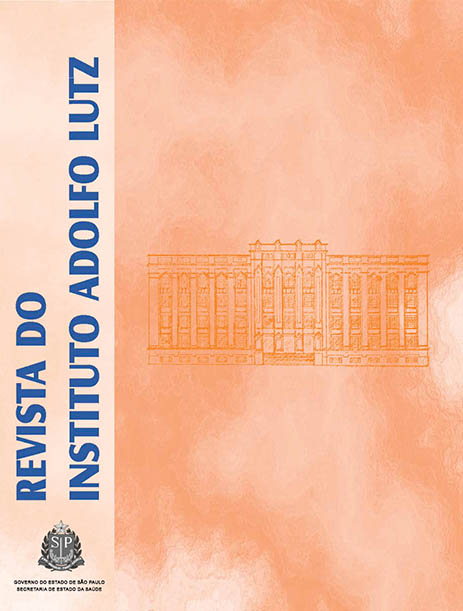Abstract
This study aimed at isolating Salmonella spp. from mussel Perna perna (L.) samples collected from natural sea beds of Palmas Island, Santos Bay, São Paulo, Brazil. During the period from August 2010 to July 2011, 10 sampling of mussels collections were performed at three distinct points. A total of 29 samples were collected, which were analyzed by methodology described in the Compendium of methods for the microbiological examination of foods. Salmonella spp. was isolated from 20.7% of samples. The Salmonella spp. strains revealed four different serotypes among the six isolates. The dominant serotype was S. Livingstone which was detected in three isolates (50%), and the other isolated serotypes were identified as S. Infantis, S. enterica subsp. salamae and S. Albany from one sample (16.6%). Two different types of Salmonella spp. strains were isolated from samples collected at each distinct point. At the point 1 S. Livingstone and S. Albany, point 2 S. Infantis and S. Livingstone, point 3 S. enterica subsp. salamae and S. Livingstone. S. Livingstone was detected in samples from the three points, being two strains in January 2011 and one in June 2011.
References
1. Klappenbach MA. Lista preliminari de los mytilidae brasilleños con chaves para su determination y notas sobre su distribucion. An Acad Bras Ciênc. 1964;37(supl.): 327-52.
2. Casarini LM, Henriques MB. Estimativa do estoque do mexilhão Perna perna e da espécie invasora Isognomon bicolor em bancos naturais da Baía de Santos, São Paulo, Brasil. Bol Inst Pesca. 2011;37(1): 1-11.
3. Gourmelon M, Lazure P, Hervio-Heath D, Le Saux JC, Caprais MP, Le Guyader FS, et al. Microbial modelling in coastal environments and early warning systems: useful tools to limit shellfish microbial contamination. In: Rees G, Pond K, Kay D, Bartram J, Santo Domingo J, eds. World Health Organization (WHO). Safe Management of Shellfish and Harvest Waters. London: IWA Publishing; 2010.p.297-318.
4. Casarini LM, Henriques MB, Graça-Lopes R, Souza MR. Chemical and bacteriological evaluation of the water and mussels of Santos bay, São Paulo, Brazil. Rev Inst Adolfo Lutz. 2010;69:297-303.
5. World Health Organization - WHO. Food safety and foodborne illness. 2007. [acesso 2011 Ago 22]. Disponível em: [http://www.who.int/mediacentre/factshee ts/fs237/en/print.html].
6. Andrews WH, Flowers RS, Silliker J, Bailey JS. Salmonella. In: Downes FP, Ito K, eds. Compendium of methods for the microbiological examination of foods. Washington, DC: American Public Health Association (APHA); 2001.p.357-80.
7. Vieira RHSF, Lima EA, Sousa DBR, Reis EF, Costa RG, Rodrigues DP. Vibrio spp. and Salmonella spp., presence and susceptibility in crabs Ucides cordatus. Rev Inst Med Trop São Paulo. 2004;46(4):179-82.
8. Ristori CA, Iaria ST, Gelli DS, Rivera ING. Pathogenic bacteria associated with oysters (Crassostrea brasiliana) and estuarine water along the south coast of Brazil. Int J Environ Health Res. 2007;17(4):259-69.
9. Rakesh K, Poothuvallil KS, Nirmala T. Evaluation of Culture Media for Selective Enrichment and Isolation of Salmonella in Seafood. J AOAC Int. 2010;93(5):1468-71.
10. Setti I, Rodriguez-Castro A, Pata MP, Cadarso-Suarez C, Yacoubi B, Bensmael L, et al. Characteristics and Dynamics of SalmonellaContamination along the Coast of Agadir, Morocco. Appl Environ Microbiol. 2009;75(24):7700-09.
11. Henriques MB, Casarini LM. Avaliação do crescimento do mexilhão Perna perna e da espécie invasora Isognomon bicolor em banco natural da ilha das Palmas, baía de Santos, estado de São Paulo, Brasil. Bol Inst Pesca. 2009;35(4):577-86.
12. Silva NJR, Reno SF, Henriques MB. Atividade extrativa do mexilhão Perna perna em bancos naturais da baía de Santos, estado de São Paulo: uma abordagem socioeconômica. Informações econômicas, São Paulo. 2009;39(9):62-73.
13. Schriewer A, Miller WA, Byrne BA, Miller MA, Oates S, Conrad PA, et al. Presence of Bacteroidales as a predictor of pathogens in surface waters of the central California coast. Appl Environ Microbiol. 2010;76(17):5802-14.
14. Silva MA, Marvulo MFV, Mota RA, Silva JCR. A importância da ordem Ciconiiformes na cadeia epidemiológica de Salmonellaspp. para a saúde pública e a conservação da diversidade biológica. Pesq Vet Bras. 2010;30(7):573-80.
15. Nunes SL. Salmonella spp. isoladas de águas e moluscos bivalves de regiões portuárias brasileiras – Suscetibilidade antimicrobiana e caracterização molecular dos sorogrupos (A-D1, B e C2-C3) [tese de doutorado]. São Paulo (SP): Universidade de São Paulo, 2007.

This work is licensed under a Creative Commons Attribution 4.0 International License.
Copyright (c) 2011 Instituto Adolfo Lutz Journal
